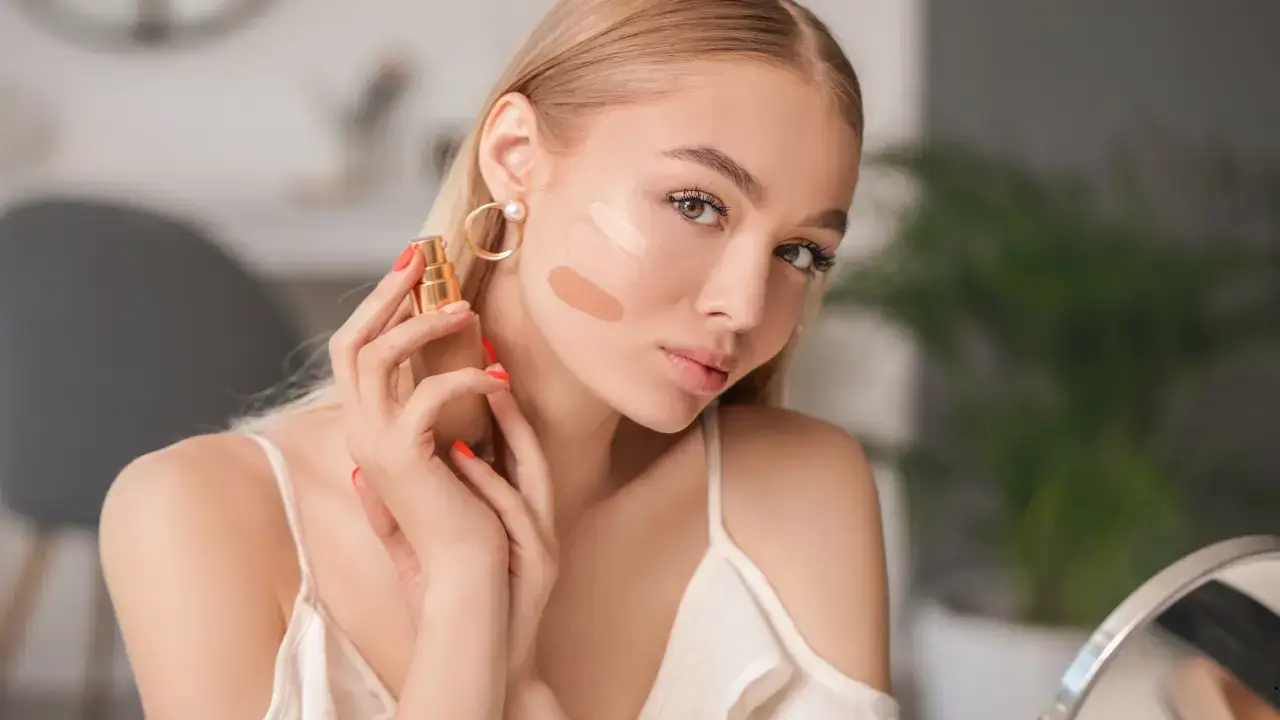Top Tips for Applying Foundation for Oily Skin

For Distributors & Wholesalers
We welcome partnerships with distributors and wholesalers who wish to expand their business with a trusted and growing cosmetic brand.
Why Partner with Avlon International?
- Wide range of cosmetics: Nail polish, mascara, kajal, eyeliner, liquid lipstick, lipstick & more.
- Premium quality with competitive wholesale pricing.
- Attractive margins and fast-moving products.
- Assured support with marketing materials & promotional offers.
- PAN India shipping with secure packaging.
📦 Minimum Order Quantity (MOQ): 1 master carton (72 trays)
💰 Special Discounts: Available for bulk & long-term partners.
🚚 Dispatch & Delivery: PAN India in around 10-15 days.
📞 Contact Us:
Phone / WhatsApp: +91 88105 67775
Email: contactus@avloninternational.com
Website: www.avloninternational.com
Oily skin can be a challenge when it comes to makeup, especially foundation. It’s common for people with oily skin to struggle with excess shine, foundation slipping off during the day, or clogged pores leading to breakouts. However, with the right techniques and products, it’s possible to achieve a flawless, long-lasting look even with oily skin.
In this blog, we’ll cover the top tips for applying foundation for oily skin, ensuring you get a matte, smooth finish that lasts all day without sacrificing comfort or your skin’s health.
You may also like:
Tips for Applying Foundation for Oily Skin:
1. Start with a Clean Slate: Cleanse Thoroughly
The first step in any makeup routine, particularly for those with oily skin, is to start with a clean, fresh face. Cleansing your skin thoroughly helps remove excess oil, dirt, and impurities that can interfere with the application of your foundation.
Opt for a gentle, oil-free cleanser that won’t strip your skin of its natural moisture but will help reduce excess oil. Ingredients like salicylic acid, tea tree oil, or charcoal can help balance oil production and cleanse your pores. Washing your face before applying makeup ensures your foundation has a solid base to adhere to, preventing it from slipping off throughout the day.
2. Don’t Skip Moisturizer (Choose Oil-Free)
One of the biggest myths about oily skin is that you don’t need to moisturize. In fact, skipping moisturizer can cause your skin to produce even more oil to compensate for the dryness. The key is choosing a lightweight, oil-free, and non-comedogenic moisturizer that hydrates your skin without making it greasy.
Look for moisturizers that contain humectants like hyaluronic acid or glycerin, which draw moisture into the skin without adding extra oil. Gel-based or water-based moisturizers are excellent options for oily skin because they provide hydration while being quickly absorbed. Applying a moisturizer before foundation ensures that your skin is hydrated and ready for makeup, helping it go on smoothly and last longer.
3. Prime for a Matte Finish
Using a good primer is essential for anyone with oily skin. A mattifying primer can make a world of difference when it comes to keeping oil at bay and helping your foundation stay put. Primers create a smooth canvas, minimizing the appearance of pores and fine lines while providing a barrier between your skin’s natural oils and your makeup.
For oily skin, look for primers that are specifically designed to control oil and shine. Ingredients like silica, dimethicone, or kaolin clay are great for absorbing excess oil and keeping your skin matte throughout the day. Apply a thin layer of primer to your T-zone (forehead, nose, and chin) where oil tends to accumulate the most, and blend it outwards for an even base.
4. Choose the Right Foundation for Oily Skin
Not all foundations are created equal, and choosing the right one is critical when you have oily skin. You’ll want to opt for foundations that are:
- Oil-Free: These foundations are formulated without oils that can exacerbate your skin’s natural shine.
- Matte or Semi-Matte Finish: Look for words like “matte,” “long-wear,” or “shine control” on the label. These formulas are designed to provide a matte finish that controls oil.
- Non-comedogenic: This means the product won’t clog your pores, which is essential for preventing breakouts.
- Long-Lasting: Oily skin tends to break down foundation faster, so a long-wearing formula will ensure it stays intact throughout the day.
Liquid foundations with a matte finish or powder foundations are usually best for oily skin. Some great ingredients to look for include salicylic acid, which helps control oil production, and micronized pigments for even coverage.
5. Apply Foundation in Thin Layers
When applying foundation to oily skin, less is more. Applying too much product can make your skin feel heavy, and excess foundation can mix with oil, causing it to break down faster. The goal is to build up thin layers for a natural, even finish.
Start with a small amount of foundation and blend it well into the skin using a damp makeup sponge or a stippling brush. These tools help press the foundation into the skin, ensuring it blends seamlessly without disturbing any of the products you’ve applied underneath, like moisturizer or primer. Using thin layers allows you to control the coverage, giving you a more long-lasting and breathable finish.
6. Set with Powder to Control Shine
Setting your foundation with a powder is a must for oily skin. A good-setting powder absorbs excess oil and helps lock your foundation in place, preventing it from slipping off as the day goes on.
Choose a translucent powder if you prefer a natural finish, or a tinted powder for added coverage. Look for powders that contain silica or cornstarch, which are effective at absorbing oil without making your skin look cakey. Focus on setting your T-zone, but you can lightly dust powder all over your face for an all-day matte look.
For touch-ups throughout the day, keep a pressed powder or blotting paper on hand to quickly mattify any areas that may become shiny.
7. Use a Makeup Setting Spray
After applying your foundation and powder, use a mattifying setting spray to lock everything in place. A setting spray helps keep your makeup intact and fresh for longer periods, especially in hot or humid conditions, where oily skin tends to get shinier more quickly.
Opt for setting sprays that are specifically formulated for oily skin. Look for alcohol-free sprays with mattifying agents that will help control shine without drying out your skin. Hold the spray about 8-10 inches from your face, close your eyes, and mist evenly to finish off your look.
8. Blot Away Excess Oil During the Day
Even with the best application techniques, oily skin will produce some shine throughout the day. To avoid disturbing your foundation, use blotting papers to absorb excess oil. Gently press the blotting paper onto the shiny areas, especially the T-zone, and avoid rubbing or wiping to prevent lifting your foundation.
Blotting papers is a quick and effective way to control shine without adding more product or reapplying powder, which can make your makeup look cakey. Keeping a pack in your bag is a must for midday touch-ups.
9. Avoid Touching Your Face
It’s tempting to touch your face throughout the day, especially when dealing with oily skin. However, touching your face can transfer oil, dirt, and bacteria onto your skin, which can cause your foundation to wear off faster or clog your pores, leading to breakouts.
To keep your foundation looking fresh and clean, avoid touching your face, and make a conscious effort to keep your hands off your skin. This will help preserve your makeup and keep your skin clearer.
10. Opt for Oil-Free, Non-Comedogenic Makeup Products
In addition to your foundation, it’s important to choose oil-free, non-comedogenic makeup products across the board. Whether it’s your concealer, blush, bronzer, or highlighter, using oil-free products ensures that they don’t contribute to excess oil production or clog your pores.
Look for powder-based products for blush and bronzer, as cream formulas can sometimes add to the oiliness of your skin. Matte or satin finishes work best for oily skin, as they minimize the appearance of shine and keep your makeup looking fresh.
Conclusion
Achieving a flawless foundation look for oily skin is all about preparation, the right products, and proper application techniques. By following these top tips, you can keep your skin looking matte and your foundation in place throughout the day. Cleansing and moisturizing your skin properly, using a mattifying primer, choosing the right foundation, and setting it with powder are all crucial steps to ensure your makeup stays flawless.
Remember, oily skin doesn’t have to mean constant shine or makeup breakdown. With the right approach, you can enjoy a smooth, matte complexion that lasts all day long, giving you the confidence to take on anything that comes your way.
FAQ’s:
1. What type of foundation is best for oily skin?
2. Should I use a primer if I have oily skin?
3. Do I need to moisturize oily skin before applying foundation?
4. How can I stop my foundation from getting oily throughout the day?
5. What’s the best way to apply foundation for oily skin?
6. Can I use setting spray on oily skin?
7. How do I prevent the foundation from clogging my pores?
📌 Disclaimer
The information provided in this blog is for general informational purposes only. While Avlon International makes every effort to ensure the accuracy and reliability of the information shared, we make no representations or warranties of any kind, express or implied, about the completeness, accuracy, reliability, suitability, or availability with respect to the content.
Any reliance you place on such information is therefore strictly at your own risk. Avlon International shall not be held liable for any loss, damage, or inconvenience arising in connection with the use of this blog or its content.
For official details regarding our products, distributor policies, or business partnerships, please contact us directly at WhatsApp +91 88105 67775.



